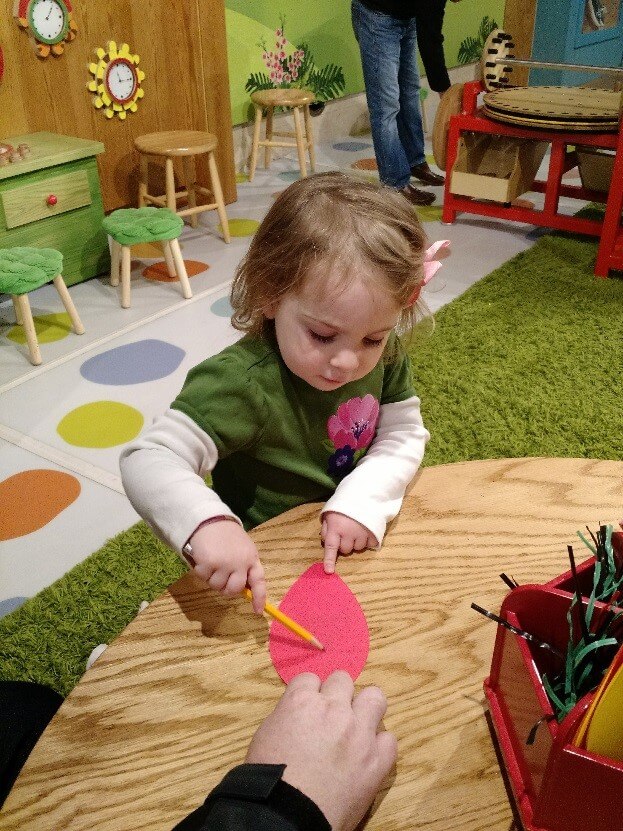Why are fine motor skills so important for learning to read, and how can we help young children to develop strong fine motor abilities?
Fine motor skills are defined as “any of the motor skills that require greater control of the small muscles than large ones, esp. for hand-eye coordination or for precise hand and finger movement. Fine motor skills include handwriting, sewing, and fastening buttons” (thefreedictionary.com).
You may wonder what fine motor skills have to do with a child learning to read.
Reading and writing are inseparable skills that work together while supporting each other. Developing and practicing fine motor skills is an effective way to prepare young children for writing (and learning) letters and numbers in the future.
Your toddler may initially begin to jab at a piece of paper with a crayon, making dots rather than lines or squiggles. You can show her how to pull the crayon along the paper to create a continuous line. That way, you begin to build the foundation skills that will allow her to learn to make circles, squares and other various shapes.
When you combine drawing activities with reading activities (labeling familiar objects, labeling a child’s belongings with their name, using your finger to follow words in a book as you read to your child) you are teaching the early literacy skill known as print awareness. In short, your child starts to learn that printed symbols and words have meaning.

The understanding that a series of letters (which young children will recognize as symbols) can combine to create words, or that symbols drawn in a particular orientation represent people, places and things are paramount to the early framework of literacy.
Move Those Mini-Muscles: Fine Motor Activity Suggestions
Infants:
- Fun with Fabric
What you need: an empty tissue box, scraps of fabric with different textures (i.e. velour, silk, fleece, lace, etc.)
What you do: Stuff the fabric scraps into the tissue box and allow your baby to reach in, pull out the scraps and examine the different textures. Re-stuff and repeat!
Why it’s good: Your baby will be exercising his finger muscles when he grasps the fabric and pulls it from the tissue box. He will also be practicing hand-eye coordination in order to reach into the box for another scrap. He is also exercising his finger muscles when he takes the time to feel and explore the textures of each fabric.
Toddlers:
- Pasta Necklaces
What you need: Uncooked, tube shaped pasta (rigatoni, penne), pipe cleaners, several plastic bags, food coloring
What you do: First dye the pasta by putting a handful or two into each plastic bag. Add a different color food dye to each bag, tip or shake the bag until all of the pasta is covered, seal the bags and allow to sit for a day. Once the pasta is dyed and dry, show your toddler how to string the pasta onto the pipe cleaners. You can make bracelets and necklaces that you and your toddler can wear.
Why it’s good: Your toddler will be developing his fine motor muscles when he grips the pasta and pipe cleaners. Threading the pipe cleaner through the hole in the pasta also develops fine motor coordination as well as hand-eye coordination. You can also introduce the concept of matching colors as well as creating patterns.
- Playdough Cupcakes
What you need: play dough, paper cupcake liners, birthday candles, large buttons/beads/seashells/fake gems, etc.
What you do: Suggest making pretend cupcakes with your child. Show her how to roll playdough into a ball shape and then encourage her to decorate her cupcake with the different materials you’ve provided.
Why it’s good: Manipulating the playdough builds strength in your toddler’s fingers and picking up the small decorative items and pushing them into the playdough builds both strength and coordination.
Preschoolers:
- Eye Dropper Art
What you need: white coffee filters, liquid watercolors (or food coloring in water), an eyedropper
What you do: Allow your child to drop different colors of water onto a coffee filter using an eyedropper. You probably want to put a paper towel underneath the filter to keep the food coloring/watercolors from staining your table.
Why it’s good: Precise and coordinated muscle control in the fingers is required to both pull liquid into the dropper as well as expel it back out onto the filter. This activity is much more about controlling small hand muscles as opposed to strength building.
- Abacus Beading
What you need: pipe cleaners cut in half, pony beads, two pieces of paper, tape
What you do: Tape the two pieces of paper end to end and write the numbers 1-10 across the top. Tape the half pipe cleaners vertically under each number. Only tape them at the top so that your preschooler can string beads onto the pipe cleaners on the lower end. Once the pipe cleaners are secured to the paper, ask her to string the corresponding number of beads onto the pipe cleaner below each number.
Why it’s good: Not only does stringing small beads on pipe cleaners reinforce fine motor strength and coordination, this activity also allows you to help your preschooler practice her counting skills in a fun, visual way.
These are just a few ideas to make fine motor development fun for both you and your child. Singing along to finger plays such as the Itsy Bitsy Spider or Patty-Cake are also simple, engaging ways to exercise little muscles in little hands. Find the activities that work best for you and just be sure to have fun while keeping those fingers flexing.
Korie is part of the Library’s Early Learning BLAST Outreach team. Her favorite children’s authors are Kevin Henkes and Audrey and Don Wood. She enjoys making sensory bottles, taking long walks through small neighborhoods and ‘80’s era fantasy films.

